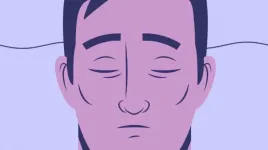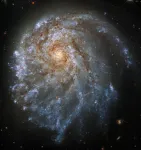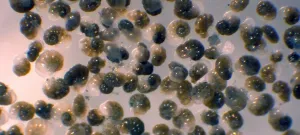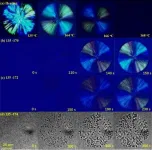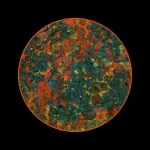Lactate reveals all about its antidepressant prowess
Neuroscientists at Synapsy have identified the mechanism behind the antidepressant effect of lactate, a molecule produced by the body during exercise. Its key features - NADH and neurogenesis - will pave the way for new treatment possibilities.
2021-05-27
(Press-News.org) Depression is the leading cause of disability worldwide. Neuroscientists from Synapsy - the Swiss National Centre of Competence in Research into Mental Illness - based at Lausanne University Hospital (CHUV) and Lausanne University (UNIL) have recently demonstrated that lactate, a molecule produced by the body during exercise, has an antidepressant effect in mice. Lactate is best known for the pivotal role it plays in the nutrition of neurons inside the brain. Yet it can also counter the inhibition of the survival and proliferation of new neurons, a loss seen in patients suffering from depression and in stressed animal. Furthermore, the research team pinpointed NADH as a vital component in the mechanism: this is a molecule with antioxidant properties that is derived from the metabolism of lactate. The findings, published in the scientific journal Molecular Psychiatry, provide a better understanding of the physiological mechanisms that underpin physical activity, which should lead to an improvement in the way depression is treated in the future.
WHO recognises depression - which affects nearly 264 million people - as the leading cause of disability worldwide. Treatments based on antidepressants and psychotherapy are available to help people suffering from the disorder. Yet, as Jean-Luc Martin, senior lecturer and researcher at CHUV's Centre for Psychiatric Neurosciences (CNP) and UNIL, Synapsy member and co-director of the study together with Professor Pierre Magistretti, points out: "Around 30% of people with depression don't respond to antidepressants." At the same time, the antidepressant effects of physical activity have been known for many years, even though the scientific community has struggled to figure out the molecular mechanisms involved.
Exercise and lactate: united against depression
During its previous investigations, the laboratory led by Dr Martin focused on lactate - a molecule produced during physical exercise - in an attempt to explain the benefits of sport. The researchers observed the antidepressant action of lactate when administered to mice at doses comparable to those found during physical activity. As the Vaud-based neuroscientist continues: "Lactate decreases anhedonia in particular, one of the main symptoms of depression, which involves losing interest or pleasure in all those activities which, prior to depression, were considered enjoyable".
Giving birth to new neurons
The CNP team was keen to delve deeper and understand how lactate acts on the brain to counter depression. They focused on adult neurogenesis in the hippocampus, a region of the brain that plays a role in memory and depression. "Adult neurogenesis is the term used for the production of new neurons in adulthood from brain stem cells", points out Dr Martin. "Its core purpose is to replace neurons, and it's known to be impaired in depressive patients, when it contributes to the reduction in the volume of the hippocampus observed in some individuals". With the help of his fellow researchers, Dr Martin was able to show that lactate restores neurogenesis and lowers depressive behaviour in mice. Conversely, without neurogenesis, lactate loses its antidepressant power, indicating that the two are intimately linked.
A key trio
But this does not tell us anything about the mechanism by which lactate regulates neurogenesis. Accordingly, the researchers studied its metabolism: in other words, all the cellular chemical reactions relating to it. Lactate is largely derived from the breakdown of glucose from food, and is then oxidised to pyruvate. Anthony Carrard, a biologist at CNP and the study's lead investigator, explains: "We logically tested pyruvate on neurogenesis, without success. So, we said to ourselves that the answer had to be found in the conversion of lactate to pyruvate".
During conversion of lactate to pyruvate, cells produce a molecule with antioxidant potential, known as NADH. As Dr Carrard continues: "It's NADH and its antioxidant properties that protect neurogenesis during a depressive episode - or at least during a modelling of some of these symptoms in animals". In conclusion, the researcher adds: "This mechanism could explain the link between sport and depression, understanding that further experiments are still needed to demonstrate it. Importantly, it offers potential targets for devising future treatments. To do this, we're first going to identify the proteins on which the NADH factor acts".
INFORMATION:
[Attachments] See images for this press release:
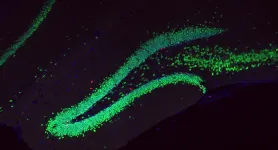
ELSE PRESS RELEASES FROM THIS DATE:
2021-05-27
Normal cells usually have multiple solutions for fixing problems. For example, when DNA becomes damaged, healthy white blood cells can use several different strategies to make repairs. But cancer cells may "put all their eggs in one basket," getting rid of all backup plans and depending on just one pathway to mend their DNA. Cold Spring Harbor Laboratory (CSHL) Professor Christopher Vakoc focuses on probing cancers to figure out if they have any unique dependencies. His lab was surprised to discover that a single DNA repair method remained in acute myeloid leukemia (AML), an aggressive cancer that originates in bone marrow. They discovered that if they shut down that pathway in cells grown in the ...
2021-05-27
New insights into the ability of DNA to overcome harmful genetic changes have been discovered by scientists at the Wellcome Sanger Institute, the University of Lausanne and their collaborators. The team found that 26 per cent of harmful mutations were suppressed by naturally occurring variants in at least one wild yeast strain. In each instance examined in detail, a single 'rescue mutation' was responsible for cancelling out another mutation that would have threatened the organism's survival.
The study, published today (27 May 2021) in Molecular Systems Biology, provides ...
2021-05-27
Millions of surgical procedures performed each year would not be possible without the aid of general anesthesia, the miraculous medical ability to turn off consciousness in a reversible and controllable way.
Researchers are using this powerful tool to better understand how the brain reconstitutes consciousness and cognition after disruptions caused by sleep, medical procedures requiring anesthesia, and neurological dysfunctions such as coma.
In a new study published in the journal eLife, a team led by anesthesiologists George Mashour, M.D., Ph.D. of University of Michigan Medical School, Michigan Medicine, Max Kelz, M.D., Ph.D. of the University of Pennsylvania Medical School, and Michael Avidan, MBBCh ...
2021-05-27
This striking image showcases the unusually contorted appearance of NGC 2276, an appearance caused by two different astrophysical interactions -- one with the superheated gas pervading galaxy clusters, and one with a nearby galactic neighbour.
The interaction of NGC 2276 with the intracluster medium -- the superheated gas lying between the galaxies in galaxy clusters -- has ignited a burst of star formation along one edge of the galaxy. This wave of star formation is visible as the bright, blue-tinged glow of newly formed massive stars towards the left side of this image, and gives the galaxy a strangely lopsided appearance. NGC 2276's recent burst of star formation is also related to the appearance of more exotic inhabitants -- black holes and neutron stars ...
2021-05-27
What does quark-gluon plasma - the hot soup of elementary particles formed a few microseconds after the Big Bang - have in common with tap water? Scientists say it's the way it flows.
A new study, published today in the journal SciPost Physics, has highlighted the surprising similarities between quark-gluon plasma, the first matter thought to have filled the early Universe, and water that comes from our tap.
The ratio between the viscosity of a fluid, the measure of how runny it is, and its density, decides how it flows. Whilst both the viscosity ...
2021-05-27
Woods Hole, Mass. (May 27, 2021) - With the expansion of oxygen-depleted waters in the oceans due to climate change, some species of foraminifera (forams, a type of protist or single-celled eukaryote) that thrive in those conditions could be big winners, biologically speaking.
A new paper that examines two foram species found that they demonstrated great metabolic versatility to flourish in hypoxic and anoxic sediments where there is little or no dissolved oxygen, inferring that the forams' contribution to the marine ecosystem will increase with the expansion of oxygen-depleted habitats.
In addition, the paper ...
2021-05-27
Twenty scientists from 14 countries warn of a hidden "pandemic within the pandemic" in two current publications. On the one hand, physical activity levels have gone down significantly, on the other hand, psychological well-being has suffered. "Governments and those responsible for health systems should take our findings seriously," emphasizes the author team, headed by Dr Jan Wilke from the Institute for Sport Sciences at Goethe University Frankfurt.
About 15,000 people in participating countries answered standardised questionaires as part of an international survey. In April/May 2020, they reported physical activity levels (13,500 participants) as well as their mental and physical well-being (15,000 participants) ...
2021-05-27
With global warming decreasing the size of New Zealand's alpine zone, a University of Otago study found out what this means for our altitude-loving kea.
The study, published in Molecular Ecology, analysed whole genome DNA data of the kea and, for the first time, its forest-adapted sister species, the kākā, to identify genomic differences which cause their habitat specialisations.
The researchers found the kea is not an alpine specialist, but rather one that adapted to using such an open habitat because it was least disturbed by human activity.
Co-author Associate Professor Michael Knapp, of the Department of Anatomy, says that is not likely to surprise people ...
2021-05-27
Different from small molecules, polymer will fold into lamellar crystals during crystallization and further assemble into lamellar stacks.
Synchrotron Small-Angle X-Ray Scattering (SAXS) is an important tool to characterize such nanoscale structure and understand polymer crystallization. However, its scattering mechanism in semi-crystalline polymers is not completely elucidated yet.
Recently, a research group led by Prof. TIAN Xingyou from Institute of Solid State Physics, Hefei Institutes of Physical Science (HFIPS), proposed a complete set of new methods to characterize polymer lamellar crystals ...
2021-05-27
Epithelial ovarian cancer (EOC) is the most common lethal gynaecological cancer. Ovarian cancer is usually treated with platinum-based chemotherapy; however, a significant number of patients are resistant to such treatments and relapse soon afterwards. To improve their survival, there is a need to first identify which patients may be platinum-resistant, so that newer treatments may be administered early.
Now, researchers from the Cancer Science Institute of Singapore (CSI Singapore) at the National University of Singapore (NUS), have discovered a way to predict which patients are resistant to platinum chemotherapy. The study, co-led by CSI Singapore Principal ...
LAST 30 PRESS RELEASES:
[Press-News.org] Lactate reveals all about its antidepressant prowess
Neuroscientists at Synapsy have identified the mechanism behind the antidepressant effect of lactate, a molecule produced by the body during exercise. Its key features - NADH and neurogenesis - will pave the way for new treatment possibilities.

